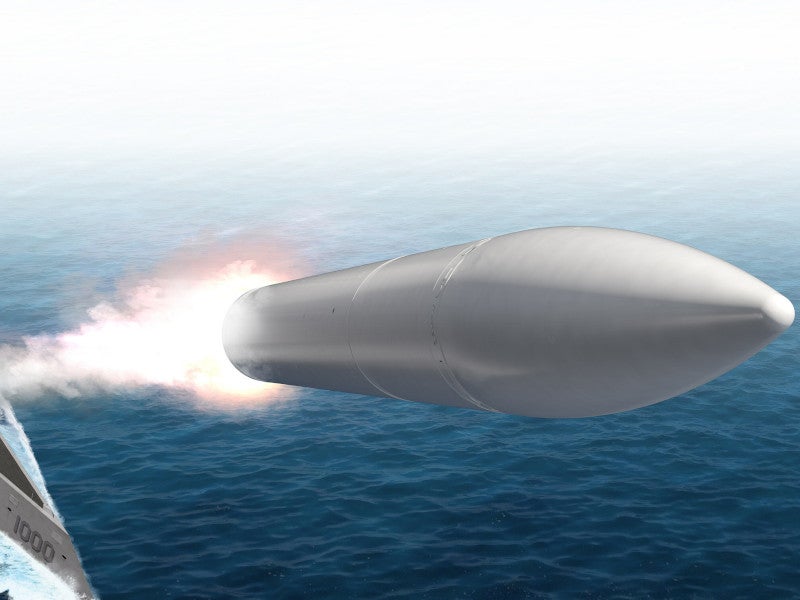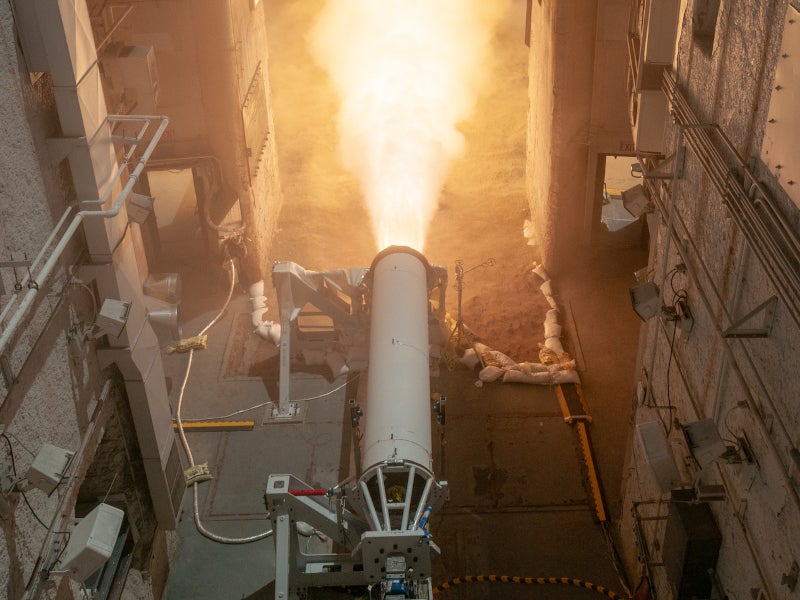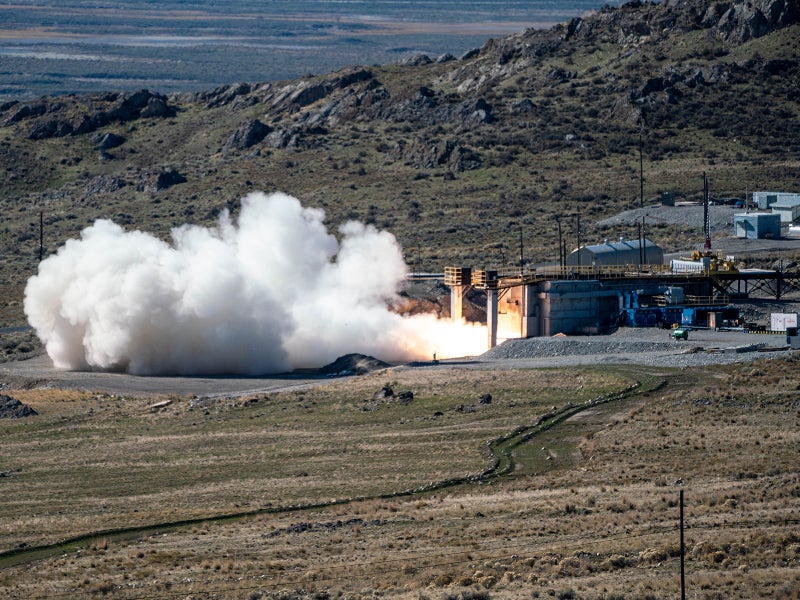Conventional Prompt Strike (CPS) is a programme designed to develop and test hypersonic boost-glide missiles for quicker, longer-range strikes with enhanced survivability against enemy defences.
The US Navy is leading the design of the hypersonic missile that will be deployed by both the US Navy and Army.
The first CPS weapon system will be deployed on Zumwalt–class guided missile destroyers, followed by the Virginia-class attack submarines.
The integration of CPS capability with the stealth and mobility of the Zumwalt–class destroyers will deliver the first sea-based hypersonic strike capability to the US.
CPS programme phases
The US Navy has a three-phase plan for delivering the Conventional Prompt Strike programme.
Phase one is the Middle Tier of Acquisition (MTA) Rapid Prototyping, which aims to develop and demonstrate a hypersonic missile system prototype launched using cold gas.
Phase two entails MTA Rapid Fielding and is designed to deploy CPS aboard a Zumwalt–class destroyer.
Phase three involves shifting to a Major Defense Acquisition Program at Milestone C to deploy CPS on Virginia-class submarines and the remaining Zumwalt-class destroyers.
In January 2023, the Navy revised the MTS to incorporate programmatic alterations and supplementary performance metrics. The revised MTS was provisionally endorsed by the Director, Operational Test and Evaluation (DOT&E) in March 2023, contingent upon the submission of the test strategies of phases two and three.
The CPS programme aims to finalise a Life Cycle Support Plan by 2024 for product support and fielding on the Zumwalt–class destroyers and the Virginia–class submarines.
DOT&E will include CPS operational effectiveness in an Initial Operational Test & Evaluation (IOT&E) report after phase three testing finishes in 2029.
The CPS programme will also supply the CPS all-up-round (AUR) missile prototypes and parts of the weapons control system for the US Army’s long–range hypersonic weapon (LRHW) or Dark Eagle programme.
The US Army plans to combine standard AURs with their weapon control system in a prototype LRHW Battery Operations Center and transporter-erector-launcher (TEL) system.
CPS programme development timeline
The US Navy framed a Master Test Strategy (MTS) for phase one of CPS in 2019. It consists of five Joint Flight Campaign–1 (JFC-1) events to assess the flight performance of the CPS AUR missile prototype and shared components of the hypersonic weapon systems in relevant mission scenarios.
A team comprising Lockheed Martin, a defence and technology firm based in the US, and Northrop Grumman, an aerospace and defence technology company also based in the US, announced the successful live fire test of the first-stage solid rocket motor (SRM) of the hypersonic strike system in May 2021.
The CPS programme was put under oversight by the DOT&E in the same year.
Testing on the second stage SRM was completed in August 2021 and a second test on the first stage SRM was completed in October 2021, followed by another SRM test in November 2021.
In February 2022, General Atomics Electromagnetic Systems (GA-EMS) reported that their Autonomous Flight Termination Units (AFTUs) aboard two sounding rockets demonstrated successful performance during a high operational tempo for a hypersonic test flight campaign at Wallops Island, Virginia.
The test was sponsored by the Navy Strategic Systems Programs and Army Hypersonic Program Office.
The AFTUs ensure missile flight safety and were tested to advance the development of the US Navy’s CPS and the US Army’s LRHW offensive hypersonic strike capability.
CPS hypersonic boost-glide weapon system details
The CPS missile will comprise a two-stage solid rocket booster and a common hypersonic glide body housing a kinetic energy warhead. The missile booster will include a thrust vector control system, enabling the rocket motors to manoeuvre during flight. Cold-gas ejection will be used for launching the missile.
The CPS hypersonic boost-glide weapon system can achieve extended missile range at speeds surpassing Mach 5.
Joint Flight Campaigns on CPS prototype
In June 2022, the US Navy tested a single CPS AUR missile prototype at the Pacific Missile Range Facility in Hawaii in the first JFC event, JFC-1. The missile encountered an in-flight anomaly during the test that impeded data collection across a segment of the planned flight profile. The root cause of the anomaly was determined and corrective measures were implemented.
In March 2023, the Navy and Army initiated flight testing of the missile prototype through JFC-2 by launching from the Army’s prototype TEL for the LRHW.
The test was, however, not executed as pre-flight checks revealed failures, preventing the launch. A subsequent attempt to conduct JFC-2 in September 2023 also resulted in a non-launch due to similar pre-flight issues.
The Navy and Army are planning to retry JFC-2 and proceed with JFC-3 in 2024. The subsequent JFCs, JFC-4 and JFC-5, are also planned to be undertaken in 2024.
Contractors involved
Lockheed Martin secured a contract exceeding $2bn in value from the US Navy to deploy the CPS weapon system on Zumwalt-class destroyers, in February 2023. It will supply launcher systems, weapon control and AURs, and provide platform integration support for the naval platform.
The company is working along with Northrop Grumman and General Dynamics Mission Systems on the programme.
Lockheed Martin is the primary weapon systems integrator while Northrop Grumman is designing the motor for the missile.
Dynetics, a subsidiary of Leidos, is developing the common hypersonic glide body for the project.
VTG, a company specialising in modernisation and digital transformation solutions for the defence sector, received an $80m prime contract from the US Navy Strategic Systems Programs (SSP) in January 2024 to provide comprehensive engineering services for the CPS programme.
VTG will deliver research and development skills, advanced systems engineering, test planning and engineering, integrated logistics, as well as a variety of programmatic and technical services to the CPS Program Office, a division of SSP.
In October 2023, X-Bow Systems, a space technology company, was awarded a $64m contract by the Office of the Assistant Secretary of Defense for Industrial Base Policy, to supply large SRMs to the US Navy and the US Army.
The SRMs will provide boost propulsion for the AURs of the CPS weapon system and LRHW.






